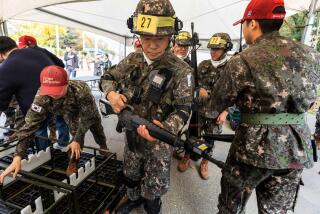He Fought a War Armed With an Air Compressor : Secret WWII Unit Misled the Germans With Inflatable Tanks
- Share via
All too quickly, as old soldiers die or their memories ebb, the tales of World War II are disappearing. Not the stories of D-Day or Bataan or Midway--the movies and the sheer volume of death will keep those episodes alive. What slips away are the little things.
Like the Army’s 23rd Headquarters Special Troops.
Never heard of it? You weren’t supposed to. More than 40 years after the 23rd shut down, Irwin VanderHeide still isn’t sure he ought to be talking about it.
“If this hasn’t been declassified,” he warns with gallant earnestness, “I’ll be up for court-martial.”
VanderHeide, 80, of Santa Monica, helped lead one of the strangest operations of the war, something that sounds more like a bad TV movie than a tiny chunk of military history.
Rubber Tanks
Picture this:
A “camouflage unit” of 1,000 artists, communications technicians and combat engineers moves through France, Belgium and Luxembourg, armed with life-size inflatable rubber tanks, airplanes and cannons; tape-recordings of cursing soldiers and rumbling equipment, amplified by huge loudspeakers; and canisters that explode like real artillery.
Under the cover of darkness, the soldiers assume the position of a real combat unit. The real unit then sneaks into better position to outflank the enemy or simply get some rest. The illusion is performed so well that the Germans--looking through field glasses at the phony unit from as little as a few hundred yards away--do not suspect that anything has changed.
That’s the trick the 23rd Headquarters Special Troops pulled off time after time during the final year of the war, beginning shortly after the Allies’ D-Day invasion on the French coast.
“The Germans never knew about us,” said VanderHeide, who commanded a signal operations company that was one of three outfits merged to form the 23rd Headquarters unit. “The Germans reported on every occasion that the regiment we impersonated was there. Sometimes the Germans were so close we could see them playing ball, but they never found out.”
That contention has never been disproved, according to David Trask, chief historian of the Army’s Center of Military History, but it has also never been studied closely enough to be confirmed “from a scholarly point of view.”
Nevertheless, Trask said, the activities of the 23rd remain of interest “because covert action and concealment are live issues in modern warfare. Surprise is a key element.”
Such surprises were the last thing VanderHeide expected in 1942. He was 36, and the chief switchman in the Santa Monica office of Associated Telephone, now known as General Telephone of California. Despite his age, he was planning to enlist, so he was glad to answer an urgent call from the Army for communications specialists. He and 22 other Associated Telephone employees signed up.
Many Moves
During the next two years he moved to posts in New Jersey, Missouri, Louisiana, San Bernardino and Tennessee, where the 23rd Headquarters unit’s participants were brought together for the first time and told what their mission would be.
“It was rather startling,” VanderHeide said with a laugh.
So was the mixture of men involved in the scheme.
There were 300 communications specialists, under VanderHeide’s command, skilled in stringing telephone wires and sending radio transmissions.
There was a combat company trained in desert warfare and put in charge of construction and security.
And there was the creative component, formally known as the 603rd Engineer Camouflage Battalion, the guys responsible for making sure that the phantom unit looked and sounded like the troops they were going to replace.
The 603rd was composed largely of artistic types, many who came from art and design schools. Some achieved success after the war. One of them was Bill Blass, a 22-year-old fashion designer.
Germination Period
The idea of bringing these specialists together had been germinating throughout the war, as the Allies tried various tricks of deception and disinformation against the Germans.
The most famous of these maneuvers came when the Allies set up phony tanks and artillery pieces on the English coast in 1944. German scout planes believed that the assembly was real, leading German military planners to incorrectly anticipate the site of the D-Day invasion.
The men of the 23rd began hitting the beaches of France a few days after D-Day.
In the summer of 1944, outside the French port city of Brest, they impersonated two tank battalions and a field artillery battalion. In an effort to bluff the Germans into surrendering the city, they moved within 500 yards of enemy lines and projected their amplified recordings of approaching tanks.
On other occasions, they pretended to be another outfit relaxing at a rest camp, staged a phony river-crossing to cover a real surprise crossing and helped cloak the movement of an infantry division in the Battle of the Bulge in late 1944.
Massing of ‘Troops’
In March, 1945, they helped stage a massing of thousands of troops on the shores of the Rhine River to storm one of Germany’s last great lines of defense. The Germans concluded that the invasion would not come for a month. But the real invasion, by the 9th Army, came weeks earlier and miles away from the mock buildup.
Painstaking effort went into preparing the fake units, VanderHeide said.
“We’d make sure to wear the patches and everything else of the units we were representing,” he said.
To make sure phony radio and telephone messages sounded right to the Germans who intercepted them, the artists and technicians used the names of the departed commanders and the same transmission habits. Other troops constructed supply dumps, scarred the ground with tread marks like those of real tanks and burned fires at night.
A crucial weapon was the air compressor that could pump up a full-size tank in half an hour. Even from a short distance the rubber vehicles were convincing, “but there were always Frenchmen wandering in and out,” VanderHeide said, “and they’d see our equipment. One time one of them looked at one of our guns and said, ‘Boom, boom, hah-hah.’ ” Other storytellers recall wide-eyed Frenchmen astonished by the sight of four GIs grabbing the corners of a tank and casually lifting it to change its position.
Returns to Santa Monica
After the war, VanderHeide went home to his job and his wife and his Santa Monica home, the same one they still live in. Folks asked him what his unit had done in the war and he answered, “Classified.”
It wasn’t until a General Telephone public relations writer stumbled across VanderHeide’s name a couple of months ago and sought him out for an interview that the former soldier spilled the beans.
Now he is having second thoughts.
There’s no need to worry. Smithsonian Magazine, aided by another member of the 23rd, published a detailed history of the unit last year.
Still. . . .
“If this (top-secret classification) hasn’t been lifted, it’d be an awkward position for me,” VanderHeide said.
More to Read
Sign up for Essential California
The most important California stories and recommendations in your inbox every morning.
You may occasionally receive promotional content from the Los Angeles Times.









